I was seven years old when I was first introduced to weaving. My doctor had prescribed six weeks of complete bed rest for me and my parents complied. However, even a very sick little girl needed something to keep her occupied. One of the tasks that landed in my bed was making potholders.
The potholder loom, as many of you may remember, is a simple square with teeth around all four sides. Jersey loopers are stretched across from side to side and then more loopers were woven through. When all the teeth are filled, the potholder is removed from the frame by slipping the loops in a chain around the edges. I was too young and too weak to manage the final step but I could do the weaving. I remember going through several bags of loopers while I was bedridden.
I was so good at potholder production that I was in charge of keeping Mom’s kitchen supplied with them until I left home at eighteen.
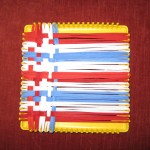
The start of a potholder
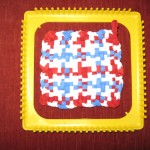
The finished potholder framed by its loom
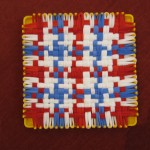
finished but still on the loom
Time marches on. I got involved with “real looms” as an adult. I kept finding ways to purchase looms with more and more harnesses so I could do more involved weaving.
Then, sometime in the ‘80’s, I bought a triangle loom.
This triangle frame was a step up from the potholder loom and the complete antithesis of what I had been doing and I suppose that was the point. It has never been my main loom or even my favorite loom, but I’ve made many shawls on it and it’s easy to take with me for demonstrations. It is also easy to break down and store when I’m not using it. There is no loom waste with this loom and I also know how much yarn I need– it’s a mathematical formula. If you’re not up to calculating, the yardage amount is mentioned in the directions. It is also a nice way to use small amounts of beautiful yarn. If you need to use more than one yarn, you will end up with a balanced plaid because of the way the weaving progresses. The down side of using it is that it is mind-numbingly boring and I need to be listening to a very engrossing recorded book to keep me at my task.
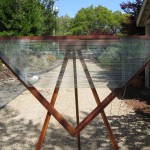
Triangle loom
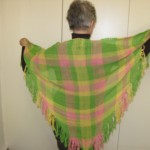
triangle shawl
Recently, I found a website for small frame looms on the internet. These are a direct descendant of the potholder loom. However, they are more sophisticated. The weaving on the square one is done from corner to corner so the finished square is on the bias. Loopers are not involved, these looms are made for yarn. Triangle hand-sized looms are also offered and they are scaled to work with the square loom. I couldn’t help myself. I ordered a set of one triangle and one square loom.
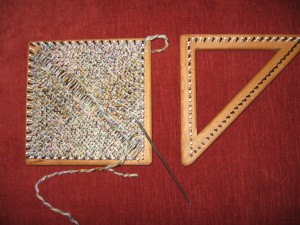
looms
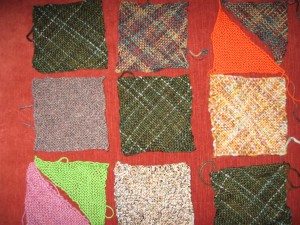
samples
My thoughts were that they would be a more portable form of weaving and I could take them when I’m traveling. Also, it would give me something to do while watching television and, like the large triangle loom, there is no loom waste.
I now have a pile of woven squares and triangles. The down side, so far, is I’m not sure what I want to do with them.
Once I started looking for pin looms, they seemed to come out of the woodwork. The May/June 2011 Handwoven had a small article about another purveyor of pin looms. The accompanying pictures showed lovely to look at wood frames in 4″and 8″squares and a 4″x 8″ oblong loom, too.
These looms are closely related to the ubiquitous potholder loom mentioned earlier as they are woven on the square. The only difference that I noticed was that the pins are grouped in sets of threes around the perimeter of the loom.
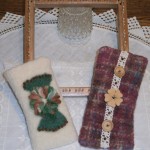
Eyeglass Cases made with the pin loom pictured -- photo courtesy of Patricia Hokenson
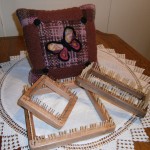
Pillow made with the acompanying looms photo courtesy of Patricia Hokenson
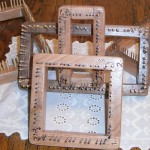
Various sizes of pin looms photo courtesy of Patricia Hokenson
The eye glass cases and the pillow were all woven, pieced together and then felted in the washing machine.
I did talk to Patricia Hokenson whose husband is constructing these looms. She thought that the set of the pins had do do with keeping track of where the weaver was on the loom.
I also have had several conversations about how to use the squares with Dianne Cutler at our guild’s retreat in February. Dianne is a talented weaver, knitter, spinner and dyer and has her own business, Spinning Stripes, for which she dyes , cards and sells wool in a rainbow of colors. She includes instructions on how to spin in order to get the colors arranged in a pleasing pattern for use in knitting and weaving. Diane volunteered that she, too, had made many sample squares –in her case, she used the ‘weave-it’ potholder loom. She also controlled the colors in each square. She made enough squares to put together two afghans measuring 36″ x 52″.
She used the weave-it project to take on trips and to meetings and she used many little orphan balls of her handspun yarn.

Afghan by Diane Cutler
More info :
Triangle looms are available through Carol Leigh’s Hillcreek Fiber Studio. www.HillCreekFiberStudio.com
Small square and triangle looms are available through Hazel Rose Looms web site
Small wooden pin looms are available from Alan and Patricia Hokenson (765) 282-0124 aphokens(at)comcast.net
‘Weaveit’ looms can be found in toy and hobby shops
Diane Cutler can be reached @ 541-942-8034 or roncut8030( at)msn.com
Now for a change of subject. Do you remember our Sutter Creek adventure?